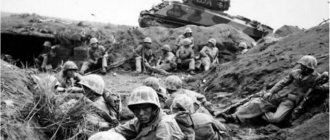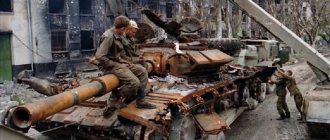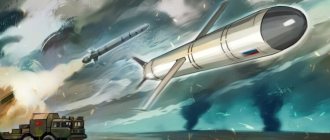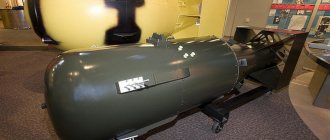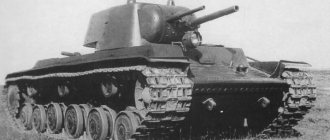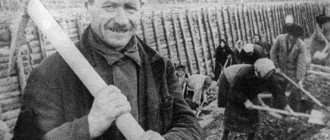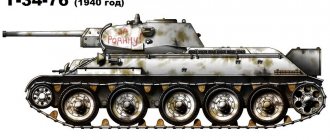Development of relations between the USSR and China
The People's Republic of China (PRC) was established on October 1, 1949 as a communist state. The country was led by Mao Zedong, who sincerely admired Stalin and his successes in governing the USSR. This admiration reached such an extent that the issue of China's entry into the USSR was seriously discussed. This did not happen, but now it is important to understand something else - the PRC and the USSR during the life of Joseph Stalin were allies with a common ideology, goals and objectives. Moreover, China, which was just emerging, was absolutely comfortable with the role of “little brother.” The deterioration of relations between the countries began after the death of Stalin.
The Soviet-Chinese conflict of 1969 did not arise overnight, but was prepared in several stages:
- Khrushchev's report exposing Stalin's personality cult (February 25, 1956). Khrushchev not only criticized Stalin’s personality, but also his policies, including international ones. This report was read at the 20th Congress of the CPSU, and what is characteristic is that at the same congress a Chinese delegation led by Zhu De spoke, who began a speech of admiration for Stalin. This was the first note of emerging contradictions.
- Simultaneously with the exposure of Stalin's personality cult, Khrushchev expressed the idea of peaceful coexistence of the two political systems. Mao was against this idea.
- In 1960, the PRC announced the curtailment of almost all economic programs with the USSR. The result was that economic projects with the USSR were reduced by 1962 to 5% of the 1959 level.
- In 1965, the so-called “cultural revolution” began in China. Its essence is that the USSR was declared the only enemy of China. Since this year, massive attempts to cross the border and provocations have begun. for example, in the first half of April alone, more than 500 Chinese illegally tried to cross the Soviet border.
- In 1966, China recalled from the USSR all undergraduate and graduate students undergoing training and conducting scientific work. At the same time, the Chinese media began to inflate the image of the USSR as an enemy.
China consistently took a hostile position towards the USSR. In response, the USSR issued a decree on April 30, 1965 - the number of border guards on the USSR-PRC border was increased. Additional forces and resources were also allocated for border engineering equipment. Subsequently, another decree was issued on February 4, 1967 - the number of border guards was increased once again. This time it reached 4 people per 1 km of the state border.
The Cultural Revolution needs enemies
The deterioration of relations between the two countries has led to the issue of the border becoming acute.
The Soviet Union did not abandon its previous promises, but bilateral consultations were not successful. The reason was acute disagreements on global issues, which were reflected in border issues.
Since the early 1960s, there has been an increasing number of minor incidents on the Sino-Soviet border, usually involving Chinese infiltration into disputed territories. Usually, Soviet border guards expelled uninvited guests without any problems, but the behavior of the Chinese became increasingly impudent.
The “Cultural Revolution” that began in 1966 in the PRC further strained relations between Moscow and Beijing. Comrade Mao pointed not only to internal, but also to external enemies.
The call to “break the heads of Soviet revisionists on the stones of Red Square” did not bode well.
Cause of the conflict
The cause of the Daman conflict of 1969 can be traced to China, since it was the PRC that initiated the conflict. This is largely due to Mao Zedong's desire to make China the leading communist country in the world. For this purpose, the “Great Leap Forward” course was announced in 1958. It was assumed that China would carry out economic reforms that would allow it to catch up and overtake the USSR, as well as Western countries. Instead, the quality of life declined greatly, and famine began in 1959. The population expressed dissatisfaction with the government's mistakes. Under these conditions, China decided to change the vector of development to rapprochement with the United States, and also to find an image of an ideological enemy on which to attribute its own mistakes and miscalculations. The USSR was chosen for this role. The justification for this was the question of the border between the countries. China questioned the 1860 Treaty of Beijing. The idea began to spread in the country that the USSR was illegally occupying part of the ancestral Chinese lands.
In general, we can say that the causes of the Soviet-Chinese conflict of 1969 are as follows:
- Death of Stalin and change of political leadership of the USSR. At the same time, a change (albeit not radical) of the political course was carried out.
- The miscalculations of the Chinese government that led to the famine of 1959, as well as the failure of the Great Leap Forward policy of 1958-1960.
- Presence of territorial disputes.
A piece of sushi in the middle of Ussuri
The epicenter of passions was the small island of Damansky on the Ussuri River, named in memory of a Russian engineer who once died in the waters of a treacherous river.
The island, about 1700-1800 m from north to south and about 600-700 m from west to east, was not of great strategic or economic value, but the struggle for control over it became a matter of principle.
In 1860, the Russian Empire concluded an extremely beneficial Beijing Treaty with China, which determined the border between the two countries from the Ussuri River to the sea.
The agreement assumed, in particular, that the border on the Amur and Ussuri ran along the Chinese coast. Thus, only representatives of Russia could conduct economic activities on rivers and islands.
Map with conflict sites in 1969. Photo: ru.wikipedia.org
Territorial disputes between the USSR and China
The border between the USSR and the PRC was fixed on the basis of the Beijing Treaty of 1860, which ratified the agreements of the Aigun Treaty of 1858. These treaties assigned the Amur and Ussuri territories to Russia, but China never stopped making claims to these territories.
In the mid-20s of the 20th century, the countries reaffirmed the significance of the Beijing Treaty of 1860 by approving the border along the “red line” - the line of the Chinese coast. The problem was that such an agreement was very beneficial for the USSR and also disadvantageous for China. After all, when the border between countries runs along a river, world practice usually speaks of the need to draw the border along the fairway (middle) of the river. In this case, Russia owned the entire river. To understand the scale, these are not only quite long rivers, but also 794 islands.
It is characteristic that in 1952 the USSR again initiated negotiations on the border. China was once again given maps with the boundaries drawn - there were no disputes or objections from the PRC. Nevertheless, already in 1959, with the onset of the famine, maps began to appear in China on which the “disputed” territories were designated as occupied by the USSR. Subsequently, every year the issue became more acute. Its highest point occurred on June 10, 1964. Mao Zedong held a meeting with the Japanese delegation, at which he stated the following:
A hundred years ago, Russia already took Vladivostok, Khabarovsk and Kamchatka from China. These are our territories that are occupied today. This account has not yet been closed by us. Therefore, my personal opinion is that the Kuril Islands should be returned to Japan.
Mao Zedong
It is characteristic that this speech was delivered during the Soviet-Chinese border negotiations. At the initiative of Moscow, negotiations on the border began on February 25, 1964. At these negotiations, Moscow admitted that the border was drawn unfairly, and it should be moved along the river fairway. The problem arose when the Chinese side laid claim to a number of islands near Khabarovsk. The Soviet side could not accept these conditions. but she offered an alternative - to sign an agreement with those points so that they were approved. This meant that the border between the USSR and the PRC had to run along the river fairway, and controversial issues should be reflected in the document, in order to later create a joint commission to resolve the problems. The Chinese side rejected this proposal and disrupted the negotiations. Thus, we can say that the USSR did everything possible to maintain peace and to come to an agreement with China. The PRC itself needed a conflict with the USSR, so resolving the border issue did not suit them. Why did China need conflict? To signal to the United States that the country’s development vector is changing.
Damansky Island
Damansky Island became a symbol of the Soviet-Chinese border conflict of 1969. What was the island because of which a full-scale war almost broke out between China and the USSR? The island is located on the Ussuri River. It is 500 meters from the Soviet border, and 300 meters from the Chinese border. Due to the border agreement, according to which the states bordered along the Chinese coast, Damansky was part of the territory of the USSR. Damansky is a small island with a width of 500 meters and a maximum length of 1.8 thousand meters. In the spring, when the Ussuri River floods, the island is almost completely flooded. There is nothing on it: people do not live here, there are no buildings, there are no objects of any kind, there are no mineral deposits. There are not even many trees on the island due to frequent floods.
This small piece of land in March 1969 became the object of worldwide attention. The choice of this island as a target of attack by the PRC once again demonstrates that the PRC was not so much resolving border issues as strengthening the image of the enemy in the USSR for the Chinese population, and also gave a clear signal to the West that the PRC is ready to cooperate with the United States.
How Mao beat Brezhnev to Damansky. What Russia needs to do to prevent this from happening again
The USSR defeated China militarily at Damansky, but lost in everything else.
The largest armed conflict in the modern history of Russia and China, which took place from March 2 to March 15, 1969 over Damansky Island on the Ussuri River, became a military victory for Russia.
However, as a result of the conflict, the island... went to the PRC, thereby winning a geopolitical victory that laid the foundation for China’s transformation into a superpower. The conflict itself was a deliberate provocation on the part of Beijing. But it was caused, let’s be honest, by the stupid policy of the Brezhnev leadership of the USSR.
Beijing decided to cynically and harshly take advantage of this, catching the USSR by surprise. In stagnant Moscow, they simply could not imagine that the recent “brothers forever” would move from a neighborly showdown with the help of fists to shooting Soviet border guards from ambushes, mutilating their bodies, torturing prisoners and at the same time loudly accusing the USSR of “aggression” against the PRC .
Background
The bloody events at Damansky, as well as a number of other incidents organized by Beijing in those days on the long Soviet-Chinese border, showed the courage, fortitude and devotion to military duty of Soviet soldiers and officers, their ability to fight in the most difficult conditions. However, all the conceivable and then still unimaginable fruits of this provocation of Mao Zedong went to Beijing. Having received everything he could from the USSR, he turned, demonstrating hostility towards Moscow, China’s policy towards the United States, thereby ensuring their interest in the PRC on anti-Soviet grounds, which the successors of the “great helmsman” so skillfully took advantage of and the fruits of which are now being reaped by the Chinese people. Only in recent years have Beijing and Washington become enemies again, since China, which the Americans allowed and helped to turn into the “workshop of the world,” is about to take away the status of the first power on the planet from the United States.
The prerequisites for the massacre on Damansky were that since Tsarist times the Soviet-Chinese border did not pass along the fairway of the Ussuri and Amur, but along the Chinese coast. This was, of course, unfair, since Chinese fishing and navigation on the border rivers were significantly hampered by this. During the years of Soviet-Chinese friendship, the Chinese were allowed to conduct economic activities on the islands of these rivers, which gravitate towards Chinese territory. But after relations cooled, especially in the 60s, instead of resolving the border problem fairly, Moscow began to insist on literal compliance with the border regime. Therefore, it was only a matter of time when fist fights between border guards and Chinese peasants and military personnel in the disputed territories would turn into the use of carbines, machine guns, machine guns, mortars, cannons, armored personnel carriers and tanks and would be crowned by the use of the USSR’s then-secret weapon - the Grad MLRS, which mowed down an entire Chinese regiment.
How it was
On the night of March 1-2, 1969, about 100 Chinese military personnel in camouflage robes, with SKS carbines and Kalashnikov assault rifles entered Damansky Island, located several tens of meters from the Chinese coast of the Ussuri, which, according to the legal regime in force on the border, was controlled by the USSR. When they discovered from the Soviet shore that there were Chinese soldiers on Damansky, two groups of border guards totaling 18 people went there to express a verbal protest and in order to persuade the Chinese to return to their territory. They were shot in cold blood, only one survived.
Having received reports of the shooting, Soviet border guards from a neighboring outpost, accompanied by two armored personnel carriers, advanced to the island. In one of them was Senior Lieutenant Vitaly Bubenin, the future first commander of the Alpha special forces unit, who, skillfully maneuvering, scattered and destroyed with machine-gun fire an entire Chinese company on the ice of Ussuri. After his armored personnel carrier was hit, the senior lieutenant and future Hero of the Soviet Union moved to another armored personnel carrier, destroyed the Chinese command post on it, after which the armored personnel carrier was hit again, and the officer was shell-shocked, but continued to lead the battle. The forces were unequal, the border guards died one by one, but did not give up their positions. And they survived. In the middle of the day, the surviving Chinese returned to their original positions. Border guards from other outposts began to approach the scene of the battle. The 135th Motorized Rifle Division deployed in the rear with artillery and installations of the BM-21 Grad multiple launch rocket system. On the Chinese side, the 24th PLA Infantry Regiment, numbering five thousand people, was preparing to enter the battle.
New provocation
A new round of conflict began on March 14, when a new group of Chinese soldiers headed to the island to reconnoiter the situation. After the Soviet border guards opened fire on them, they retreated to their territory. In the middle of the day, border guards received orders to leave the island, but Chinese soldiers began to capture it after that. However, when eight Soviet armored personnel carriers rushed towards them, the Chinese retreated, and Damansky was again occupied by border guards. The next morning, the island came under heavy mortar and artillery fire before being stormed by 400 to 500 Chinese soldiers. Accurate fire was opened on Soviet armored personnel carriers and four T-62 tanks. Two armored personnel carriers and a tank containing the head of the 57th border detachment, Colonel Democrat (such a strange name!) Leonov, were hit. The last one was killed by a sniper while trying to leave a burning car. Due to the enormous numerical superiority of the Chinese, the border guards, who ran out of ammunition, were forced to withdraw from the island. But the aggressors who occupied it rejoiced early. At five o'clock in the evening, not giving a damn about Moscow's indecisiveness, the commander of the Far Eastern Military District, Lieutenant General Oleg Losik, ordered the Chinese to be taught a lesson. For ten minutes, thanks to the use of the Grad MLRS, Damansky’s territory turned into hell. The Chinese group suffered terrible losses, lost reinforcements and ammunition that flew into the air, after which motorized riflemen and border guards easily returned Damansky. They repulsed all further attempts to capture it by the Chinese, who did not take into account the losses. After everything calmed down, the Soviet side withdrew its troops from the uninhabited and flooded island, where it was difficult to supply them, and soon, because of the spring, it would become impossible to keep them. Silence reigned on this section of the joint border.
Results of the conflict
On September 11, 1969, Chairman of the Council of Ministers of the USSR Alexei Kosygin, returning from Hanoi to Moscow via Beijing, held negotiations at the airport with the Premier of the State Council of the People's Republic of China, Zhou Enlai. The prime ministers agreed to stop hostile actions and that the troops remain in their occupied positions and do not occupy Damansky - it became, as it were, a draw. Chinese armed provocations on other sections of the joint border have also ceased. By the end of the year, however, Damansky... was gone, after the Chinese “peacefully” filled up the 47-meter channel that separated him from their bank.
In total, during the clashes on Damansky, the Soviet side lost 58 people killed or died from wounds, and about a hundred military personnel were wounded. Five border guards received the title of Hero of the Soviet Union, including three posthumously. Chinese casualties in killed and wounded ranged from approximately 700 to 1,000. Chinese data is very disingenuous on this score.
Why did China need this?
It is clear that Mao Zedong did not start this conflict for the sake of Damansky. He needed it for a number of important domestic political and, most importantly, foreign policy reasons. Let's start with the last ones. Back in October 1968, at the plenum of the CPC Central Committee, a decision was made to rapprochement with the United States. To do this, it was necessary to interest Washington, draw attention to itself as an ally in the confrontation with the USSR, and provide the United States with important services in the hope of reciprocity. A series of armed provocations on the Sino-Soviet border perfectly suited these goals. She was noticed and appreciated in Washington. In April 1971, the now living Henry Kissinger, the right-hand man of President Richard Nixon, secretly visited Beijing. During the negotiations held in the capital of the People's Republic of China, Kissinger said that the United States was no longer an enemy of China and would support the proposal to restore China's membership in the UN. A few months later, Kissinger came to China again to sort out the details of cooperation in various fields on an anti-Soviet basis. In the same year, Taiwan's place in the UN Security Council passed to the PRC, which was thus recognized as a world power. In February 1972, US President Richard Nixon visited China, cementing the anti-Soviet alliance with Beijing. According to Kissinger, this course "reflected the geopolitical reality arising from the anxiety of increasing Soviet power" and was intended to encourage the USSR to "restraint and cooperation."
The parallel “cooperation” with Moscow that also began under Nixon was skillfully imitated by the Americans—for the time being. The Chinese greatly helped the United States to lure Brezhnev and Co. into the trap of detente, which had fatal consequences for the USSR. In addition, in order to avoid a war on two fronts, Moscow had to spend huge amounts of money on strengthening the long joint border with China, which slowed down the development of the country’s economy, and keep a large group of troops near the border. It was the army that insisted on the construction of the then premature, in all other respects, extremely costly Baikal-Amur Mainline as a military road. Since the Trans-Siberian Railway runs for thousands of kilometers only 30–50 kilometers from the Chinese border, this posed a serious threat to the supply of troops during a possible war with China. The Soviet-American ABM and SALT I treaties were also beneficial to China, since both leading military powers limited themselves in areas in which the Chinese were unconditionally inferior to them, giving Beijing the opportunity to calmly close the gap. In short, the “Chinese card” helped Washington win the Cold War and eliminate the main threat at that time in the form of the USSR, and China, after the death of Mao Zedong, who was much worse at economics than politics, became the “workshop of the world” and fit into the world economy , develop the country, get rich. So, even on military needs alone, China today spends four times more than Russia, which remains a military superpower.
The domestic political goals of Beijing’s provocation at Damansky included the consolidation of Chinese society on a patriotic basis, which led to the completion of the first, most destructive stage of the “cultural revolution” and allowed Mao Zedong to prevent the degeneration of the communist nomenklatura along the Soviet model. So, in particular, in September 1971, Marshal Lin Biao, who was considered the heir to the “great helmsman,” lost the struggle for power in the PRC and died in a plane crash while trying to escape to the USSR. He was posthumously declared a traitor and removed from the lists of the Chinese Communist Party. And all this goes back to just one provocation carried out by Beijing a little more than half a century ago.
Drawing conclusions
Time heals wounds, and today between a diminished Russia and an energized China - based on the rejection of the hegemonic policies of the United States - there are relations of “comprehensive partnership and strategic interaction”, characterized, in particular, by a “high degree of political trust” and “close and effective coordination in the international arena." For over 10 years, China has been Russia's largest trading partner, thanks to which it survived into the 20th century as a single state. In 2005, the countries resolved the territorial issue. Moscow finally showed common sense by agreeing to draw an interstate border along the center of the Amur and other border rivers, as a result of which China received a territory with a total area of several hundred kilometers that was practically unused in the Russian national economy. The PRC currently has no plans for expansion to the north. Beijing's eyes are turned to the South China Sea, the reintegration of the Chinese "Crimea" - Taiwan, and the expansion of international economic interaction through the implementation of a number of ambitious transnational projects within the framework of the "One Belt - One Road". The Americans oppose this, but Russia, on the contrary, supports it.
However, all this should not reassure and make the Russians forget what happened at Damansky. World politics, as we see, is very changeable. Moreover, today China is much more powerful than Russia, and who knows in which direction this block will turn tomorrow. Under Putin-sympathizer Xi Jinping, whom US President Joe Biden calls a “thug,” we have nothing to fear. But if the “Komsomol members” and “Shanghaiites” who are oriented toward the United States return to power in the PRC, there is no longer any complete confidence that this will not threaten Russia. What if they one day come to an agreement with the Americans again and conclude a new deal at our expense?
In any case, if Russia feels bad, the Chinese will not so much help as take advantage of it. This has always been the case with everyone - there is no place for nobility in interstate affairs, regardless of personal relationships between politicians. Therefore, for China to truly respect Russia, for Russian-Chinese relations to flourish and become stronger, regardless of who rules in Beijing, Russia must develop at an accelerated pace and be strong.
Only this can be a one hundred percent guarantee that nothing like Damansky will ever happen again.
Progress of the conflict
The first attempts to cross the border by the Chinese military were recorded in December 1968. That month, 30 people crossed the border of the USSR, started a fight with Soviet border guards and left. This is what General Bubenin, a participant in those events, writes about this.
This was in mid-December 1968. 30 Chinese soldiers crossed the border and, waving their weapons, rushed at us. Several of our soldiers were immediately stunned by blows from the butt. After that, we ordered our soldiers to use rifle butts. A real massacre began, but the enemy fled
Vitaly Bubenin, Major General
The Chinese attacks continued throughout December 1968 and January 1969. There was a lull in February, but it ended on March 2.
Events of March 2, 1969
The Soviet-Chinese conflict on Damansky Island began on March 2, 1969. On this day, at 4 o'clock in the morning, 300 Chinese troops crossed the border and set up an ambush on Damansky Island. At this time, military exercises were taking place in the USSR, in which military personnel from border outposts also took part. There were 2 soldiers left on guard at the border section. They did not notice the movement of the Chinese.
At approximately 10:40, another 30 people of the People's Liberation Army of China (PLA) moved out of Chinese territory and also moved towards Damansky. This movement was noticed. The border outpost was raised to arms. 13 people were sent to Damansky, led by officers Strelnikov and Buinevich. This movement was carried out without reconnaissance and the border guards did not know about the ambush prepared by the Chinese.
At 11:20, Soviet border guards approached the Chinese and demanded that they leave USSR territory. In response, the Chinese military opened fire from an ambush. All Soviet border guards were killed except one - private Gennady Serebrov. Later he spoke.
We divided into 2 groups and moved in such a way as to always keep the group of the head of the outpost in sight. Then we saw the Chinese lying in the snow. they were aiming at us. A moment later the shooting began
Gennady Serebrova, private
After the shot, the reserves of the outpost, as well as the composition of neighboring border outposts, were drawn to Damansky. As a result, it was possible to repel the Chinese advance and force them to leave the island.
Events of March 14-15, 1969
After the events of March 2, both countries began to gather troops to the border. For the first time it became clear that the war between the USSR and China was real. It was also clear that the leaderships of both countries were not ready to conduct peaceful negotiations and come to an agreement. The result was the continuation of the Soviet-Chinese conflict on March 14 and 15, 1969. The chronology of events is as follows:
- On the afternoon of March 14, a group of Chinese military attempted to penetrate Damansky Island.
- Soviet border guards were ordered to occupy the island. On the night of March 14-15, 45 people and 4 armored personnel carriers were transferred to Damansky. There were still 80 people with equipment on the shore to support the group of border guards.
- At 10:00 on March 15, the Chinese military began shelling Damansky and at the same time the infantry went on the offensive. In 2 hours, 3 waves of attack were repulsed. Soviet border guards lost 2 armored personnel carriers.
- 10:00 14:00 - the battle acquired a focal character of waves: first the Chinese attacked, then the Soviet border guards.
- Due to the clear numerical superiority of the enemy, at 15:00 the Soviet border guards received an order to retreat and leave Damansky to the enemy.
- At 17:00 an order came from Moscow to use artillery to suppress the Daman conflict. As a result, fire was opened on the island occupied by the Chinese military from the Grad system.
- 17:10 - 17:20 - artillery shelling of Chinese positions on the banks of the Ussuri. The strike was very successful and after 1 hour the PLA troops left Damansky.
The use of USSR military artillery for suppression forced the PRC authorities to change plans. If before March 15, 1969, the PRC did not believe that the Soviet leadership would dare to use the army for border conflicts, then after that the situation changed.
Hot 1969
The year 1969 was marked by two more lesser known Sino-Soviet border conflicts.
On May 2, about a hundred PLA soldiers, under the guise of driving sheep, invaded Soviet territory near the village of Dulaty in the Kazakh SSR. Soviet border guards did not enter into open conflict. Having blocked the intruders from all sides, they began to gather forces. For two weeks, both sides strengthened their positions, concentrating a large number of infantry, tanks, artillery and aircraft near the border. On May 18, realizing that the Soviet command was ready for a tough rebuff using any means, the Chinese withdrew their troops to their territory.
The second skirmish in the area of Lake Zhalanashkol (also Kazakh SSR) did not happen without direct confrontation. On August 13, a dozen and a half Chinese, disguised as shepherds, crossed the border and began to demonstratively set up defensive positions on the Kamennaya Hill directly opposite the Soviet border outpost. While the border guards were waiting for reinforcements, reserves also arrived to the Chinese. A Soviet armored personnel carrier, which drove out to meet them, came under fire and responded with fire from a heavy machine gun, and a battle ensued. Border guards, supported by a maneuver group in armored personnel carriers, attacked the Chinese at the top of the hill. The battle was fierce, the surrounded provocateurs were not going to surrender and had to be thrown with grenades, it almost came to hand-to-hand combat. As a result, two Soviet border guards were killed and 10 more were wounded. The Chinese lost 21 people, one was captured.
Participants in the battles on Damansky during the award ceremony in the Kremlin
Conflict resolution
The events at Damansky became the culmination of the armed conflict between China and the USSR in the 60s of the 20th century. However, in March 1969, the threat of a full-scale war between states remained. Western intelligence agencies were confident that war was inevitable. Moreover, in August of the same year, they handed over documents to the Chinese side that revealed the USSR’s plan for a preventive strike on China’s nuclear facilities. At the same time, the White House condemned the Soviet-Chinese conflict. threatening world security. This showed that the United States did not intend to take sides, and therefore it was better for the USSR and China to negotiate peacefully.
The first peace consultations were held in early September 1969. The negotiations took place at Beijing airport. The Soviet side was represented by Kosygin, the Chinese side by Zhou Enlai. The result of this meeting was an agreement that the countries should return to discussing controversial border issues (recall that the negotiations were curtailed in 1964). After this, it became clear that the culmination of the conflict had passed and the countries had entered the path of negotiations.
“Where are the people? “Yes, everyone is on the ice, fighting with the Chinese!”
By the beginning of 1969, representatives of the border troops reported to the Kremlin: China was preparing a major action on the border. Among the possible areas of future events, Damansky Island was also indicated.
The directive of the Soviet leadership read: “Do not open fire, do not give in to provocations!”
© RIA Novosti / Soviet-Chinese border conflict in 1969. A riotous crowd of Red Guards with quote books from Mao Zedong is trying to break into the territory of the USSR.
Meanwhile, at the border it had already reached hand-to-hand combat.
Yuri Babansky, one of the heroes of the events at Damansky, recalled:
“We were sent to the 2nd outpost of the Iman border detachment, now the famous Nizhne-Mikhailovka. At that time, intense fights were taking place there. Almost every day, fist fights broke out on the ice of Ussuri with the Red Guards, who were making claims to our islands. On January 25th I was thrown from a helicopter. I arrived at the outpost. I look - it’s empty. Kolya Dergach, a fellow countryman, met me at a vocational school together. “Where are the people?” - asked him. - “Yes, everyone is on the ice, they are fighting with the Chinese!” Then a car pulled up for help: cooks, stokers. I grabbed someone’s machine gun and, together with everyone else, moved forward. I remember it was a frosty sunny day. And I, who came from the detachment and stayed at the garrison “lip,” warmed up a little there.”
© RIA Novosti / G. Bibik / Junior Sergeant Yuri Babansky, took command in the battle with the Chinese on Damansky Island, after the death of Senior Lieutenant Strelnikov.
Chinese media accused Soviet border guards of attacks on Chinese civilians. Public opinion was led to the conclusion that Soviet provocations deserved a tough and decisive response.
Historical meaning
The Daman military conflict between the USSR and China had very important consequences. The result of these events was:
- Formation of the triangle system “USSR - USA - China”. Neither country could dominate alone. Only the united countries gained an advantage.
- China has finally changed its foreign policy course towards rapprochement with the United States.
In February 1972, US President Richard Nixon arrived in Beijing. He held a series of meetings with Mao Zedong, which resulted in the signing of the Shanghai Communiqué. This document stated that the United States and China renounced attempts to dominate East Asia, and also promised to jointly rebuff any country that wants to dominate this region. In return, the PRC promised to continue its policy and move away from Moscow. As a result, US foreign policy doctrine was changed. If previously it was a policy of “dual containment” (USSR and China), now only the USSR needed to be contained.
Sources and additional material on the topic:
- “Big Draw: USSR from Victory to Collapse” - Popov V.P. Moscow, 2005
They didn't back down
Everyone in Strelnikov’s group died. Heavy fire was also opened on Rabovich’s group, in which almost everyone was also destroyed.
Junior Sergeant Yuri Babansky took command of the surviving border guards. His squad was delayed in moving from the outpost and managed to disperse, joining the armored personnel carrier crew into battle.
The Chinese advantage was overwhelming. After 20 minutes of battle, eight people remained alive in Babansky’s group; after 35 minutes, five remained alive.
A group of 23 border guards from the 1st outpost “Kulebyakiny Sopki” under the command of Senior Lieutenant Vitaly Bubenin came to their aid.
Bubenin made a decisive contribution to the outcome of the battle on March 2. In his armored personnel carrier, he went behind the Chinese, shooting the infantry. When the armored personnel carrier was hit, Bubenin and his subordinates returned to the Soviet shore, moved into the armored personnel carrier of the deceased Strelnikov and carried out a new attack. This time he managed to destroy the Chinese command post. However, when trying to evacuate the wounded, a second armored personnel carrier was also hit.
But time was won. The Chinese understood that new reinforcements were about to approach the border guards. At about 13:00, Chinese units began to withdraw from Damansky.
© RIA Novosti / G. Bibik / Senior Lieutenant Vitaly Bubenin, who was wounded in battle during a provocation on the Soviet-Chinese border on Damansky Island on the Ussuri River on March 2, 1969, is being treated in a hospital.
In 1991, Damansky became Zhenbao
The Chinese side did not make any new attempts to solve the problem by force. Beijing realized that the USSR was ready for a big fight, although it was not eager to participate in it.
There were no more major clashes: the Chinese tried to enter Damansky in small groups, but they were driven away by warning fire.
In September 1969, at the Beijing airport, the heads of government of the USSR and the People's Republic of China, Alexei Kosygin and Zhou Enlai, held blitz negotiations, at which an agreement was reached to cease hostile actions.
At the same time, the Soviet side de facto recognized Chinese claims to Damansky:
the day before the negotiations, the border guards were ordered not to open fire on the Chinese, and they took advantage of this and entered the island.
The border to Ussuri was drawn up according to international standards, that is, along the main fairway, already under Mikhail Gorbachev.
In 1991, Damansky Island was officially transferred to the PRC, becoming Zhenbao (“Precious”).
In all conscience, of course, he should have been called Bloody.
They fought for their homeland
In the battles on Damansky, units of the Soviet army and border guards lost 58 people killed and 94 wounded. How much the Chinese lost is still unknown.
© RIA Novosti / Chernov / Border guards at the Nizhne-Mikhailovka outpost receive parcels and letters from residents of the USSR, expressing admiration for the heroism and courage of the border defenders.
Five servicemen were awarded the title of Hero of the Soviet Union for their participation in the battles on Damansky Island: Colonel Democrat Leonov (posthumously), Senior Lieutenant Ivan Strelnikov (posthumously), Junior Sergeant Vladimir Orekhov (posthumously), Senior Lieutenant Vitaly Bubenin, Junior Sergeant Yuri Babansky.
Several dozen people, dead and alive, were awarded orders and medals.
Senior Lieutenant Vitaly Bubenin, who was wounded and concussed in the battles on Damansky, after recovery, entered the Military-Political Academy named after V.I. Lenin, and a few years later became the first commander of the legendary special forces "Alpha".
Although today the island is under the jurisdiction of the PRC, it continues to be a symbol of heroism for Russian citizens who honor the memory of the dead.
The soiled embassy
When at half past two reinforcements arrived at the battle site, led by the commander of the Iman border detachment, Colonel Democrat Leonov, all that remained was to sum up the results of the bloody day.
31 border guards were killed and 14 more were injured. According to data subsequently received through the USSR KGB, Chinese losses on March 2 left about 39 people killed.
After the Chinese left the island, on Damansky they began to search for and collect the bodies of the dead border guards.
Their appearance horrified even seasoned officers and doctors: the Chinese soldiers did not take prisoners, finishing off the wounded with point-blank shots and mocking the dead, mutilating and shredding the bodies with bayonets.
In the same horrific condition, the body of the only captured border guard of Nizhne-Mikhailovka, Corporal Pavel Akulov, was returned to his homeland a month and a half later...
All this resembled the beginning of a war rather than a border incident. Moreover, the Chinese were not going to stop. The deployment of the 24th PLA Infantry Regiment with a total strength of about 5,000 people began on their shores.
Pravda and its Chinese counterpart, People's Daily, exchanged angry editorials in which each side blamed its opponent.
In Beijing, a demonstration took place at the USSR Embassy. In Moscow the answer was yes: the Chinese embassy was bombarded with vials of ink, as well as other polluting objects. The police calmly watched what was happening. Nothing like this happened in the capital until 1999, when the bombing of Yugoslavia began and demonstrators threw whatever they could at the US Embassy.
© RIA Novosti / Vyacheslav Runov / Protest demonstration at the Chinese Embassy in Moscow against the provocation on the Soviet-Chinese border on Damansky Island on March 2, 1969.
“Whoever remembers the old is out of sight, whoever forgets the old is out of sight.”
What exactly is Putin? / Tired, kind Putin, / After all, he is not Shvonder, who heads the house committee. / We love him, he’s almost cozy, / Like Brezhnev in ’78. /
What remained for him back in 2004? It is obedient to be friends with the “big brother”, especially since the agreements have already been signed and not by him.
Some are inclined to see this as a possible solution to the Kuril problems. But especially zealous defenders of Russia, which has risen from its knees, see Putin’s merit in the fact that he did not give away all the territorial gains in the Far East, and even compare him with Muravyov-Amursky, who annexed these lands.
There are three levels of state participation in world politics.
First -
the level of a superpower, when the country itself determines its goals and independently achieves their implementation.
Second
the level is that of a middle-peasant country: it no longer defines goals, but only its own priorities within the goals of others that it recognizes as acceptable.
And finally the third
level - when a country can do little on its own and therefore chooses such a strong partner, within the framework of whose policy it arranges its existence; the calculation is based on the fact that the patron power will provide certain protection to the client power.
Our level is far from the first. And, apparently, in this case, Putin made a useful move for a second-level state - he tried to be in an alliance with the desired power. If for this we had to sacrifice a certain amount of river backwaters and washed-up sandy islands, then this price seems acceptable, if we do not count, or rather forget, the human losses that we suffered at Damansky in 1969.
